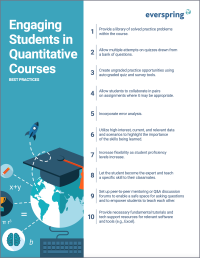Search
There are 6 results.
Tag
Tag
All (47)
Alt Text (1)
Analytics (1)
Assessments (2)
Asynchrony (2)
Backwards Design (1)
Belonging (3)
Canvas (1)
Collaboration (3)
Color Contrast (1)
Communication (6)
Community (4)
Content Creation (12)
Copyright (1)
Course Maintenance (2)
Course Materials (9)
Course Preparation (6)
Discussions (1)
Diversity (4)
Equity (2)
Faculty Presence (1)
Faculty Support (2)
Feedback (1)
Formative Assessments (1)
Images (1)
Inclusion (8)
Learning Objectives (2)
Multimodality (3)
Page Design (1)
PowerPoint (1)
Qualitative courses (1)
Quantitative courses (1)
Representation (2)
Revision (1)
Rubrics (1)
Screen Readers (1)
Synchrony (3)
Third-Party Tools (1)
Universal Design for Learning (UDL) (3)
Video (1)
Visual Accessibility (2)
Ten Ways to Open the Gate to Accessibility
According to the United States Census Bureau, over 57 million Americans, nearly one in five people in the U.S. population, report living with a disability. To make certain all your students can have a successful learning experience, it is important to take steps to make the online learning environment accessible. Here are 10 strategies for making your online course space accessible to all users.
No Sweat Alt Text
What is “alt text”? Alt text is descriptive text linked to an image, graph, or other visual content that allows users to understand the visual without viewing it. Any image online should contain alt text, but guidelines differ depending on whether the image is simply decorative or related to other content on the page.
Building Your Online Course With the Lister Model
You are building a course for the online environment. What an exciting adventure! When building an online course, you might use a similar method to what you used when developing a course previously, or you might use an entirely new technique. Either option is a good option. But you may have a few questions when you first begin: How do I organize my materials? How do I display my materials? How do I make sure my students work together?
Harnessing the Third Space Theory for Effective Learning and Instructional Design Consultation
The Third Space theory, introduced by postcolonial theorist Homi K. Bhabha, explores a transformative space where new identities and meanings emerge through the interaction of diverse cultural elements. This "third space" is characterized by hybridity, challenging rigid, binary notions of identity and culture, and emphasizing fluid negotiations between dominant and marginalized perspectives (Burke, 2012; Lin, 2014). Bhabha’s theory builds on Ray Oldenburg’s (1999) concept of the "third place"—an informal public space where people gather to form a community that is neither home nor work—and extends it into the realms of cultural and social discourse, creating a broader framework for negotiating power, identity, and cultural exchange (Bhabha, 2012). These third spaces can emerge in a variety of contexts, including both physical locations like cafés or parks and virtual environments such as online forums or social media platforms, making the theory applicable to both in-person and digital interactions.






